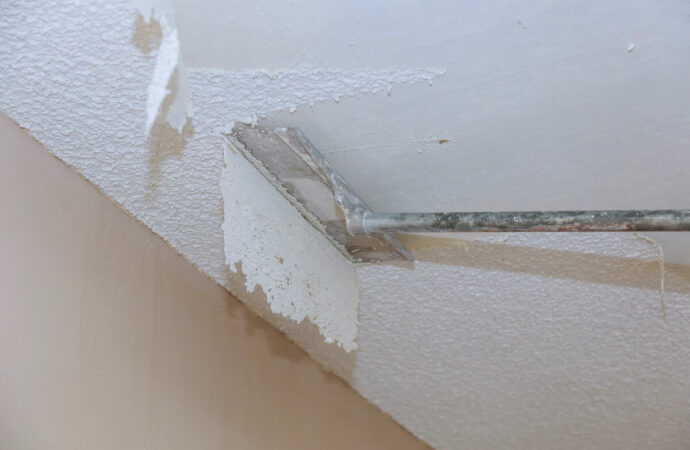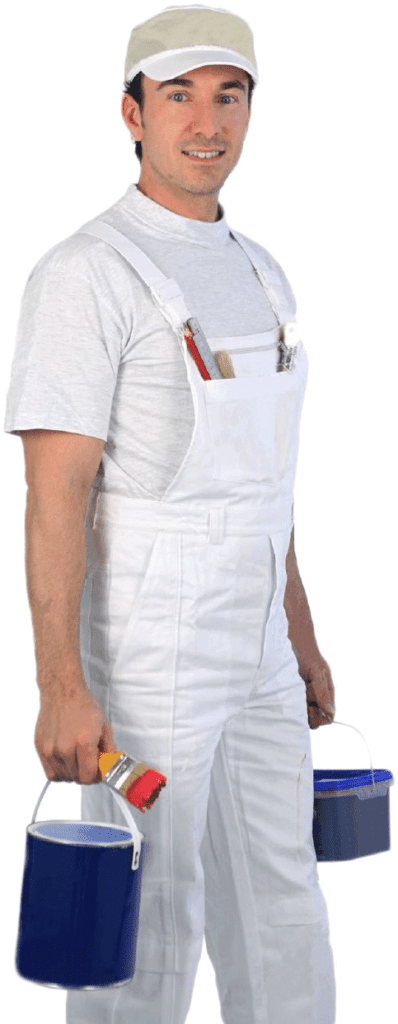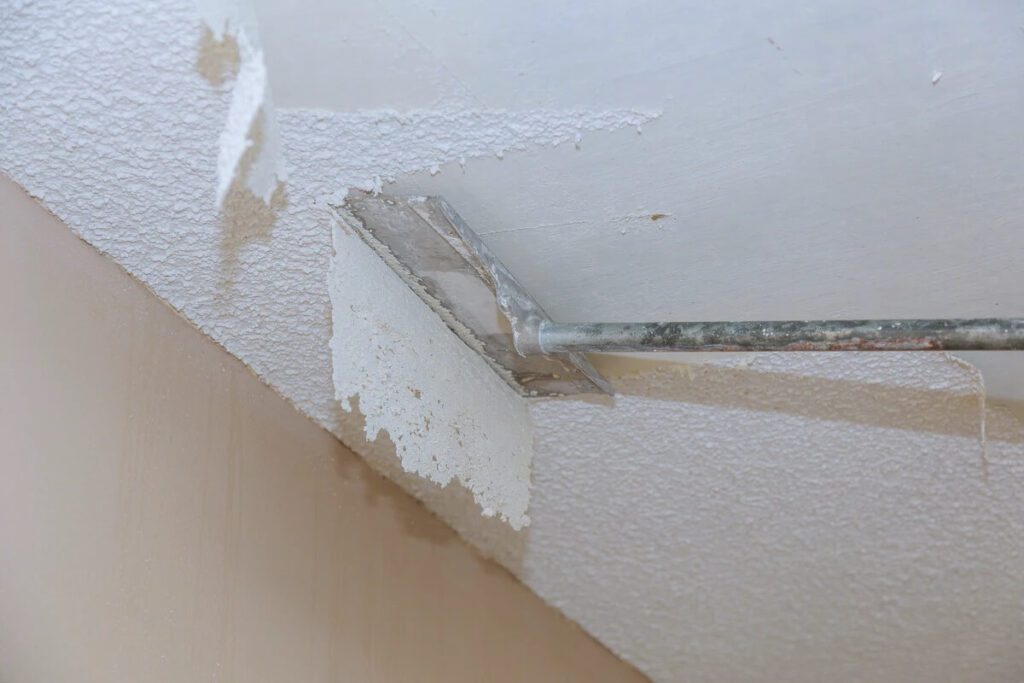Residential Popcorn Ceiling Removal
Contact Us

These ceilings are still popular today and were popular in homes built between the 1970s and 1990s. You can achieve the unique texture by spraying a mixture similar to cottage cheese onto your ceiling and allowing it to dry. This was a cheap alternative to properly painting ceilings on all types of buildings. The texture helped hide imperfections and didn’t require as much painting. Popcorn ceilings can absorb sound and are famous for apartment buildings and homes.
People prefer the modern, smooth, or lightly textured look of ceilings. There are diverse methods to get rid of popcorn ceilings. But it is essential to realize that it can be difficult and costly.
How to Clean Popcorn Ceilings
Dust is the main problem when keeping popcorn ceilings clean. Dust is a significant problem with popcorn ceilings. Textured ceilings can collect dust, so be sure to clean them before you start. A microfiber brush attachment or vacuum should be sufficient. You can use a liquid cleaner with a soft cloth if there is staining. Try a small area first because the texture can sometimes disintegrate when it becomes wet.
How to Remove Residential Popcorn Ceilings
There are a few ways to change the texture of old popcorn ceilings. Let us look at a few of the most well-known methods.
Scrape Off Popcorn Ceilings
While scraping is the most time-consuming, it’s also one of the most popular. While it is slow and messy, it’s also the most cost-effective. It doesn’t require a large group of people. One person could do it if you so desired, but it would make for a tedious job. You should note that popcorn finishes and paints from before 1979 often contained asbestos and lead. If they are airborne, both of these substances can cause respiratory problems. Consult an expert if you live in an older house to test the paint for asbestos and lead. Do not scrape the ceiling if there are positive tests.
Once ready to start, gather your tools: a 4-inch utility knife, a 6″ floor scraper, and a putty blade. Dusty surfaces will be covered with drop cloths, such as plastic sheeting. Dust masks are also recommended. To start, you have two options: clean the ceiling dry or mist it lightly with water to loosen it up. It’s then a matter of carefully and slowly scraping the ceiling, moving in small sections around until you’re finished.
You will need to sand down the popcorn ceiling, apply drywall plaster and then sand again to create a smooth surface. It can be difficult and time-consuming, so hiring professionals to remove popcorn ceilings is the best option.
Cover It with a New Texture
A textured ceiling can be a great option if you don’t like the look of a perfectly smooth ceiling. It is still necessary to prepare for a new finish. First, you must clean the ceiling and equip it with quick-set drywall glue. Once the ceiling has dried, a bonding compound (such as joint compounds) must be applied. Finally, the finishing texture should be applied. Before you begin, make sure to have a professional inspect it. They will be able to determine if the ceiling is strong enough to support the added weight of new materials. It is possible for the ceiling to fall due to excessive compound.

How to Paint Popcorn Ceilings
A popcorn ceiling can be pretty challenging to get off. It’s easier to paint the surface and leave the texture. First, prepare the room. Paint will likely drip when you paint a ceiling. Cover all floors, furniture, and other items with drop cloths—Mask or tape any ceiling fans and fixtures.
Additionally, you will likely need more paint. To achieve full coverage on textured surfaces, you will likely require twice the amount of paint you usually use. If you are hiring professional painters to paint your walls, you should consider this. You will need to budget for more paint. Oil-based ceiling paint is best if the ceiling is unpainted. It is easy to tell if the ceiling has not been painted by running your fingers across it. If popcorn crumbles while you do this, your ceiling is not painted.
Residential Popcorn Ceiling Removal Tool vs. Similar Scraping tools
The tilted handle of a popcorn ceiling remover tool is $25 to $50 and provides the best angle for pushing into dampened material. The lower frame houses trash or plastic shopping bags to catch most of it. The blade’s round corners also limit the gouging of delicate seam tape or drywall paper surfaces.
However, these same features render it useless for any other purpose than texture removal. Are there other scraping tools you can use?
A 6- or 12-inch drywall taping knife can be used to remove popcorn texture. However, it’s more complex than using texture scrapers.
Taping knives have straight handles, making it harder to work at a low angle. Taping knives cannot attach to extension poles. You will have to work entirely from a ladder.
Taping knives are sharp and can tear drywall papers. To fix this problem, use a grinder or metal filing to round off the corners.
Safety considerations
Your textured popcorn ceiling could contain asbestos if installed between 1945 and 1980. If it’s inhaled, friable, airborne asbestos could cause lung cancer and mesothelioma.
How to Use a Popcorn Ceiling Removing Tool
To remove residential popcorn ceiling texture, you will need a ceiling texture cutter, a threaded extension pole, and a 1-gallon pump-sprayer. It would help if you also had kitchen-size trash bags, plastic sheeting, and duct tape.
Protect flooring
Install plastic sheeting throughout the floor. Spread the sheeting about 1 foot up the walls. Tape the seams.
- Attach Catch Bag
- Attach the bag the size of a kitchen to the bottom with the clips.
- Attach Extension Pole
The extension pole can be screwed into the back end of the scraper handle. For better control, you can remove the extension rod if desired.
Use a sprayer
Fill the pump sprayer in warm water until it reaches the maximum fill line. You can pressurize your sprayer by pressing the handle down until the handle feels stiff and spongey. This should take about 10 to 15 pumps.
Texture for Dampen Popcorn
Sprinkle water on an area of approximately 4 feet x 4 feet. Ensure to soak the popcorn texture thoroughly, but not too much so that it is dripping. Avoid soaking more than 16 square feet at once, as they will dry out before you can remove them.
The texture of Scrape Popcorn
Keep the scraper parallel to the ceiling and slide it forward for 2 feet. The texture should come off the ceiling and fall into the bag. After three to four scrapes, empty your catch bag into a trash can.
Finish at Walls
Scrape down to the wall. Push the ceiling against the wall. A clean broom can remove the peeling texture that is difficult to sever.
Tips and Troubleshooting for Ceiling Texture Scraper
The best residential popcorn ceiling removal tools for unpainted popcorn ceilings have been painted with flat-painter paint. You can paint with any gloss, including eggshell, satin, and semi-gloss. This prevents water from soaking in the popcorn texture.
It is crucial to change the catch bag often to avoid overloading the tool. Scrape in the direction where the joint tape runs to avoid ripping it. Expect to have some gouges or scrapes. You can fix them by using drywall compounds to smoothen the surface and lightly sanding.
After scraping, thoroughly dry the damped drywall with a fan before you paint. For ceilings with intricate ceilings, it is better to cover the popcorn texture in 1/4-inch or 1/2 inches of drywall rather than removing it. After removing the popcorn texture, the drywall may need some repairs before being painted.
How much is it to remove popcorn ceilings?
Popcorn ceiling removal can be difficult and time-consuming. A licensed professional is the best choice to ensure that your popcorn ceiling is removed safely. There may be asbestos in the ceiling. In these cases, it is a good idea to consult Wellington Pro Painters & Popcorn Removal before beginning the project.
What is the best way of removing popcorn ceilings?
You will need a 4-inch utility knife (or a drywall knife) to remove the popcorn ceiling texture and make a smooth surface. You will need to smoothen the surface with a thin coating of joint compound.
Why do it?
This is the most commonly used method to remove popcorn ceilings. While it can be messy and time-consuming, this is the most cost-effective method of removing popcorn ceilings. It can also be completed in one person. But, paint and popcorn finished before 1979 were often contaminated with asbestos and lead. This could make them toxic if they get airborne. A home test for lead paint is recommended for older homes. Consult an expert to determine if asbestos has been detected. Don’t scrape it if it tests positive.
Even if your ceilings do not have asbestos or lead paint, it might be difficult to scrape them. Because the popcorn material has soaked up the paint, it will be almost impossible to get rid of it. They may be better if drywall is used.
Although many people spray their ceilings with a lot of water, it will make your ceiling sloppy and heavy. If it expands and cracks, it will also cause it to become a messy mess. While it takes more time, getting it off the ceiling is worth it.
Drywall Cover-up
Ceiling-grade gypsum boards are lighter than standard wallboards and can be used over existing popcorn ceilings. You’ll need to attach the job securely and know how to mud and tape to make the job seamless.
Why do it?
This is better than scraping if your lead paint or asbestos is present. It allows you to encapsulate harmful substances instead of sending them airborne. You will get the best results if you apply mud and tape properly. You can also hire a team of experts to do the job in no time. You can also make significant cuts in the ceiling to repair damage or route HVAC or electrical wiring. They’ll be covered up soon enough.
This method comes at a cost. A 4-by-8-foot sheet of ceiling-grade gypsum boards costs $9 each. If you DIY, it might be challenging to maneuver the panels alone. If you have crown molding, it will likely need to be removed and replaced.
Hire a drywall lifting company to do your DIY removal.
If you’re doing it yourself, rent a crane to lift the drywall. It will cost you about $40 per Day (the Home Depot pricing varies depending on where you live), but it’s safer than DIY and allows for better material control.
Skim Coat in a New Design
Although it is still a texture, Wellington Pro Painters & Popcorn Removal says that it is making a comeback, and it’s easy for homeowners to do. Often found in older homes–pre-popcorn-era–this textured ceiling involves cleaning and prepping the existing substrate with quick-set drywall mud, applying a bonding agent like joint compound, and then using a finishing combination with a trowel or knife to create a new texture.
Locations We Serve
We offer the above services at the following locations within Wellington:
Additional HOAs We Service
If you are located in Palm Beach County and you don’t see your city/area listed above, don’t worry! We cover all of Palm Beach County. Fill out the contact form above or CLICK HERE and send us a message. We’ll get back to you asap!
Here is a list of our services you can get at Wellington Pro Painters & Popcorn Removal:
-
Commercial Painting Near Me
-
Commercial Popcorn Removal Near Me
-
Drywall Repair Near Me
-
Drywall Installation Near Me
-
Knockdown Texture Near Me
-
Orange Peel Ceilings Near Me
-
Residential Painting Near Me
-
Residential Popcorn Removal Near Me
-
Smooth Ceiling Finish Near Me
-
Commercial Painting Services
-
Commercial Popcorn Removal Services
-
Drywall Repair Services
-
Drywall Installation Services
-
Knockdown Texture Services
-
Orange Peel Ceilings Services
-
Residential Painting Services
-
Residential Popcorn Removal Services
-
Smooth Ceiling Finish Services
-
Commercial Stucco Installation Near Me
-
Complete EIFS Reinstallation Near Me
-
Custom Stucco and Texturing Near Me
-
Denglass Framing Near Me
-
EIFS Inspection Near Me
-
EIFS Installation Near Me
-
EIFS Wall Systems Near Me
-
Exterior Kitchen Stucco Near Me
-
New Construction Stucco Near Me
-
Stucco Application Near Me
-
Commercial Stucco Installation Services
-
Complete EIFS Reinstallation Services
-
Custom Stucco and Texturing Services
-
Denglass Framing Services
-
EIFS Inspection Services
-
EIFS Installation Services
-
EIFS Wall Systems Services
-
Exterior Kitchen Stucco Services
-
New Construction Stucco Services
-
Stucco Application Services

